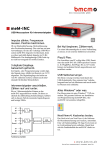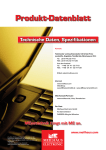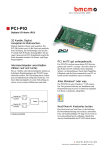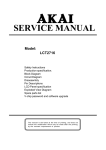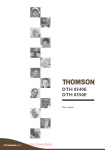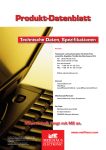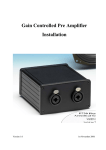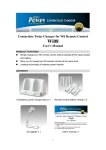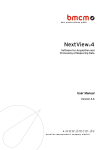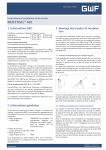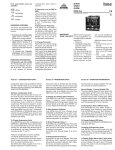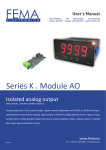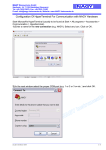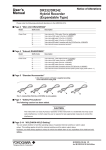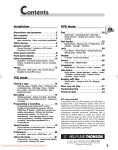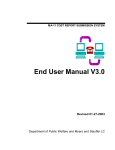Download USB-AD16f
Transcript
USB-AD16f
Data acquisition system (USB)
Measurement & Control.
Extremely powerful.
Precisely record and output signals with the
USB-AD16f: The high-performance USB data
acquisition system accomodated in a stable
aluminum housing impresses by high technical
standard and excellent price-performance ratio. It
is especially suitable for dynamic applications.
Clearly safe.
Due to the galvanic isolation of the analog
channels the DAQ system and the PC are
perfectly protected.
16 analog inputs. 250kHz
16 bit. ±10V, ±5V, ±2V, ±1V.
16 analog inputs can be sampled with 16 bit
resolution and 250kHz total sampling rate so that
even slightest peaks of high-frequent signals do
not remain undetected. The measuring range is
selected via software for each channel separately.
2 analog outputs. 16 bit. ±10V.
The two 10V outputs can be used for analog
controls with 16 bit accuracy.
4 digital inputs/outputs each.
1 counter.
Digital states are recorded or set at four digital inputs and outputs each. Digital inputs are sampled
time-synchronously with the analog inputs. The
additional counter input is galvanically isolated.
Plug & Play.
The connection to the PC is realized via USB.
The USB-AD16f provides all typical USB
features (e.g. Plug&Play, Hot-Plug). Up to 127
devices can be connected and installed during
operation.
Powered by USB.
The device is supplied with power via the USB
interface. This reduces cabling efforts to a
minimum and makes mobile measurements a lot
easier.
Open for everyone.
Widely supported: The data acquisition system
can be used under Windows® 7/XP as well as
under MAC OS X, Free BSD and Linux. The
complete software for installation and programming of the USB-AD16f is included for free.
NextView®4. Try for free.
The DAQ system is supported by NextView® 4,
the software for data acquisition and analysis. A
fully functional 30-day trial is included with
delivery to directly test the functionality of the
USB-AD16f.
Functional diagram
USB-AD16f
1
Start-up procedure
Install the bmcm driver package (see chapter 5.1.1). Plug the red frames onto the short sides of the device
with the feet looking downward as to be seen in the product picture. Connect one end of the USB cable to the
device and the other to the USB-interface of the PC and start the Plug&Play installation (see chapter 5.1.2).
The device is supplied with power via the USB-connection.
If necessary, further software components can be installed now, as described in chapter 5.
2 Analog inputs and outputs
The 37-pole D-Sub female connector at the front of the device is
designed for the connection of the analog inputs and outputs. The
following table shows the pin assignment of the 37-pole D-Sub
connector:
Pin
USB-AD16f
Pin
USB-AD16f
1
2
3
4
5
6
7
8
9
10
AIn 1
AIn 2
AIn 3
AIn 4
AIn 5
AIn 6
AIn 7
AIn 8
AIn 9
AIn 10
11
12
13
14
15
16
17
18
19
20..37
AIn 11
AIn 12
AIn 13
AIn 14
AIn 15
AIn 16
n. c.
AOut 1
AOut 2
AGND
The max. potentials to ground must not exceed ±12V. Any
channel overload may influence measurements of other
channels and may lead to wrong values.
The internal connection of the 16 analog inputs is provided via
a 40-pole pin connector (see figure on the right) on the
USB-AD16f board, which for example can be used to connect
current shunts (available as accessory under: ZU-CS250R).
The pin assignment of the 40-pole pin connector is listed in
the following table:
Pin
USB-AD16f
Pin
USB-AD16f
1
3
5
7
9
11
13
15
2, 4, .., 30, 32
AIn 1
AIn 2
AIn 3
AIn 4
AIn 5
AIn 6
AIn 7
AIn 8
AGND
17
19
21
23
25
27
29
31
AIn 9
AIn 10
AIn 11
AIn 12
AIn 13
AIn 14
AIn 15
AIn 16
n. c.
33, 34, .., 39, 40
Page 2
USB-AD16f
3 Digital inputs and outputs
The USB-AD16f features 4 digital inputs and outputs each (low:
0V..0.7V; high: 3V..5V) and an isolated counter input. The 5V
auxiliary voltage at pin 6 can be used e.g. for sensor supply.
All connections are led to the 15-pole D-Sub female connector on
the back of the device. The pin assignment is as follows:
Pin
USB-AD16f
Pin
USB-AD16f
1
9
2
10
3
11
4
12
DOut 1
DOut 2
DOut 3
DOut 4
DIn 1
DIn 2
DIn 3
DIn 4
5, 13
6
7
14
8, 15
DGND
VUSB (4-5V; max. 20mA)
counter input low
counter input high
n. c.
• The digital lines are protected by 1kΩ resistors. If the input voltage is not within the permitted
voltage range of 0V..5V, the device may be damaged.
• The digital inputs and outputs are not galvanically isolated except for the counter.
• The digital ground (DGND) is connected with the PC ground.
4 Interfacing examples for the digital lines of the USB-AD16f
The following basic connection examples demonstrate the use of the digital inputs and outputs and the
connection of a counter to the USB-AD16f. The pin assignment of the 15-pole D-Sub female connector is
described in chapter 3.
4.1
Interfacing examples for the
counter input
The galvanically isolated 16-bit counter is
connected at pin 7 and 14.
At maximum performance (216-1), the
counter is reset and starts from zero again.
Page 3
USB-AD16f
4.2 Interfacing examples for digital inputs
The 3.9kΩ pull-down resistor sets the input to low if no voltage is applied there.
4.2.1
Connecting an optocoupler
Optocouplers provide optimum protection
at each input line. With them, it is possible
to connect higher voltages and to protect
the hardware from being destroyed.
In this regard, please also see application
examples of the optocoupler you use.
Optocoupler boards with 8 or 16 inputs
are available at bmcm.
4.2.2 Connecting
switch
a
push-button
/
Please make sure to use a push-button with
debounce protection, because otherwise
several pulses might be recorded.
The 3.9kΩ pull-down resistor is absolutely
necessary to create a defined low signal!
4.2.3
Connecting a voltage divider
If connecting a DC voltage higher than 5V,
a voltage divider must be used so that 5V
at the maximum are applied at the device
input. Exceeding the 5V input voltage
might cause damages to the device.
The relation between the two resistors to be
used is calculated with the following
formula:
U/U1= (R1+R2)/R1
Input voltages less than 5V are also
sufficient (high ≥3V).
Page 4
USB-AD16f
4.3 Interfacing examples for digital outputs
Serial resistors in the output lines limit the current and protect the hardware from being destroyed.
4.3.1
Connecting an LED
Only so-called low-current LEDs can be
used, because they already work with 1mA
current.
Please also observe the total current listed
in the technical data (see chapter 7).
4.3.2
Connecting a relay
A connected relay is ideal to switch higher
currents. Since the field coil of the relay
requires a higher current than provided by
the measurement system at one line, a
transistor is connected ahead.
Relay boards with 8 relays or 16
semiconductor relays are available at
bmcm.
4.3.3
Connecting a lamp
A transistor can be used to switch higher
loads. The selected transistor must comply
with the maximum switchable current.
The figure on the right shows an
application with a maximum current of
100mA.
Page 5
USB-AD16f
5 Software installation
All software and documentation available for the USB-AD16f are integrated on the "Software
Collection" CD included with delivery. When inserting the CD, a CD starter opens automatically
(otherwise: start openhtml.exe).
USB-AD16f
Change to the product page of the USB-AD16f by selecting the entry "Products" in the CD starter
and then the hardware ("USB-AD16f") listed under the interface "USB".
For detailed information about installing or operating the software, please see the corresponding
manuals. The Adobe Acrobat Reader is required to open the documentation in PDF format.
You can run the installation directly from CD. If your browser prevents this, first save the
setup program to hard disc before running it separately.
Software Software product Notes
Device
driver
Programming
BMCM-DR
(driver package)
STR-LIBADX
STR-LIBADX-EX
SDK-LIBAD
Operating
program
NV4.5
1. install driver package to hard disc
2. Windows® Plug&Play installation
ActiveX control for hardware independent
programming
example programs for LIBADX ActiveX control
SDK with example programs for C/C++ on
Windows®, MAC OS X, FreeBSD, Linux
measuring software NextView®4 available in the
Standalone versions:
"slim" version with basic functions
• Lite:
full version with complete functional
• Pro:
range
• Analysis: version for the analysis of stored
measuring data
Documentation
IG-BMCM-DR
(driver installation manual)
IG-LIBADX
(installation / programming manual)
UM-LIBAD4
(installation / programming manual)
DS-NV4
(data sheet)
UM-NV4
(user manual)
"First steps" in the NextView®4
demo project (displayed when first
starting the software)
NextView®4 can be used for free as a fully
functional 30-day trial version. After purchasing
the software, all projects, measurement files, and
settings can still be used.
5.1
Driver installation
Under Windows®, the driver installation is always required for the USB-AD16f. Only then
additional software can be installed. To make sure the installation is done correctly, please follow
the instructions in the order as described below.
Under MAC OS X, FreeBSD and Linux, driver installation is not necessary.
5.1.1
Install driver package
The prior installation of the bmcm driver package BMCM-DR to the hard disc of your PC makes the driver
search for Windows® much easier. Especially in case of driver updates, only the new driver package has to
be installed, the hardware automatically uses the new version.
The link to install the driver package is located on the USB-AD16f product page of the "Software
Collection" CD.
Page 6
USB-AD16f
5.1.2
Plug&Play installation
As soon as the device is connected to the PC, the system announces the new hardware ("USB-BASE"). Since
the driver package has been copied to hard disc before, the hardware will be installed automatically under
Windows® 7. Under Windows® XP, the automatic hardware detection is started by selecting the following:
- Windows® 7: no specifications required
- Windows® XP: "Install the software automatically" (SP2: do not connect with Windows® Update!)
5.1.3
Check installation
The entry "Data Acquisition (BMC Messsysteme GmbH)" is included in the Windows® Device Manager
after successful installation displaying the installed bmcm hardware. To open the Device Manager, proceed
as follows:
- Windows® 7: Start / Control Panel / System and Security / System / Device Manager
- Windows® XP: Install Start / Control Panel / System / TAB "Hardware" / button "Device Manager"
Double click the "USB-BASE Analog/Digital I/O Board" to show the properties of the USB-AD16f. For
general information, existing device conflicts and possible sources of error, see TAB "General".
5.2 Programming
Programming the USB-AD16f with Visual Basic®, Delphi®, Visual C++™ under Windows® 7/XP is possible
with the hardware independent STR-LIBADX. It is available on the USB-AD16f product page of the
"Software Collection" CD. After installation, the ActiveX control must be loaded into the respective
programming environment.
- Visual Basic®: menu "Project / Components", entry "LIBADX Object Library 4.0"
- Delphi®:
menu "Components / Import ActiveX", entry "LIBADX Object Library 4.0"
If you select the entry STR-LIBADX-EX listed directly under the installation program of the corresponding
ActiveX control, you can install example programs (with source code) demonstrating how to apply the
ActiveX control.
Programming the USB-AD16f under Max OS X and Unix (FreeBSD, Linux) with C/C++ is done
by means of the LIBAD4 programming interface.
The SDK-LIBAD for the respective operating system (also Windows®) is included on the product
page of the USB-AD16f. For further information about how to integrate the SDK in the
programming environment, please see the corresponding programming manual UM-LIBAD4.
Using the LIBAD4 requires advanced programming experience!
5.3 Using USB-AD16f with NextView®4
Install the fully functional trial of the professional software NextView®4 for measurement data acquisition
and processing to directly test the features and functions of the USB-AD16f.
The setup program NV4.5 is available on the product page of the card. When first starting the
software, request a license number with the option "Request 30 days free trial version" being checked
and select your DAQ system (USB-AD16f) in the following dialog "Device Setup".
The data sheet and the start project of NextView®4 contain first instructions about how to install and operate
the program. For detailed information, an online help is provided.
The trial is valid for 30 days after requesting the license number. If a license is not purchased
within this period, the functional range of NextView®4 will be considerably cut down!
Page 7
USB-AD16f
6 Important notes for using the USB-AD16f
•
•
•
•
•
•
The device is only suitable for extra-low voltages - please observe the relevant regulations! For reasons relating to
EMC, it must only be used in closed PC housings. ESD voltages at open lines may cause malfunction.
Only use non-solvent detergents for cleaning. The product is designed to be maintenance-free.
Signal cables are connected at the 37-pole or 15-pole D-Sub female connector – preferably use shielded cables. For
best possible interference suppression, connect shield at one end only. Close open inputs if necessary.
The device ground and the chassis are electrically connected to the chassis of the PC, which is usually also
connected to ground. Be sure to avoid ground loops since they will cause measuring errors!
The gain is adjusted to even values. Therefore, only 64000 values (for 16 bit) of the full range of the converter are
used. As a result, the measuring ranges are slightly larger (e.g. ±10.24V) than the indicated measuring ranges so
that overranges can be recognized.
The device must not be used for safety-relevant tasks. With the use of the product, the customer becomes
manufacturer by law and is therefore fully responsible for the proper installation and use of the product. In the case
of improper use and/or unauthorized interference, our warranty ceases and any warranty claim is excluded.
Do not dispose of the product in the domestic waste or at any waste collection places. It has to be either duly
disposed according to the WEEE directive or can be returned to bmcm at your own expense.
7 Technical data
(typical at 20°C, after 5min., +5V supply)
Analog inputs
Channels // Resolution:
16 single-ended electrically isolated from PC // 16 bit
Sampling rate:
max. 250kHz total sampling rate*
Measuring ranges:
±10V
±5V
±2V
±1V
Noise in the relevant meas. range:
±5 LSB
±7 LSB
±8 LSB
±8 LSB
Surge protection:
max. ±35V (when turned on), ±20V (when turned off), max. ±20mA in total of all input channels!
Input resistance // Input capacity:
1MΩ (with PC turned off: 1kΩ) // 5pF
Zero shift // Gain drop:
±50ppm/°C // ±50ppm/°C
Frequency accuracy // Frequency drift:
max. ±50ppm // max. ±50ppm/°C
* The total sampling rate is the sum of the sampling rates of the individual used channels (e.g. if 5 channels are scanned with 50kHz, the total
sampling rate adds up to 250kHz).
Analog outputs
Voltage range // Output current:
Resolution // Accuracy:
Zero shift // Gain drop:
2 voltage outputs with ±10V // 1mA max.
16 bit // typ. 1mV
±50ppm/°C // ±50ppm/°C
Digital inputs/outputs
Channels // Level:
Current pick-up per output pin:
Surge protection:
Counter:
4 input and 4 output channels // CMOS/TTL compatible (low: 0V..0.7V; high: 3V..5V)
1mA (with app. 4V level), max. 2.5mA (with app. 3V level)
max. ±5.5V, protected with 1kΩ, max. max. ±20mA in total of all channels!
1MHz, 16 bit, galvanically isolated, 5..12V input voltage
General data
Power supply:
USB interface:
Connections analog:
Connections digital:
CE standards:
ElektroG // ear registration:
Max. permissible potentials:
Temperature ranges // Relative humidity:
Dimensions // Protection type:
Delivery:
Available accessories (optional):
Warranty:
+4.5V..+5.5V from USB connection to the PC, max. 100mA
USB 2.0 compatible (full speed)
all channels at a 37-pole D-Sub female at the device front
all channels at a 15-pole D-Sub female at the device back
EN61000-6-1, EN61000-6-3, EN61010-1; for decl. of conformity (PDF) visit www.bmcm.de
RoHS and WEEE compliant // WEEE Reg.-No. DE75472248
60V DC acc. to VDE, max. 1kV ESD on open lines
operating temp. 0..70°C, storage temp. –25..+85°C // 0-90% (not condensing)
167 x 113 x 30 mm3 // IP30
device in aluminum housing, 1m USB connection cable, "Software Collection" CD, description
DIN rail set ZU-SCHI, current shunt ZU-CS250R,
connecting cables ZUKA37SB, ZUKA37SS, D-Sub plugs ZU37ST, ZU15ST,
optocoupler board OI16, connector boards ZU37BB/CB/CO, waterproof housing ZU-PBOX-PG
2 years from date of purchase at bmcm, claims for damages resulting from improper use excluded
Software
Software on CD (included):
NextView®4 (optional):
ActiveX Controls LIBADX (hardware independent) for programming on Windows® 7/XP;
LIBAD4 SDK for C/C++ programming on Windows® 7/XP, Mac OS X, Unix (FreeBSD, Linux);
trial version of the measuring software NextView®4 to test and operate the hardware
professional software (versions: Professional, Lite) for the acquisition and analysis of measurement
data on Windows® 7/XP
Manufacturer: BMC Messsysteme GmbH. Subject to change due to technical improvements. Errors and printing errors excepted. Rev. 2.1 11/26/2012
Page 8









